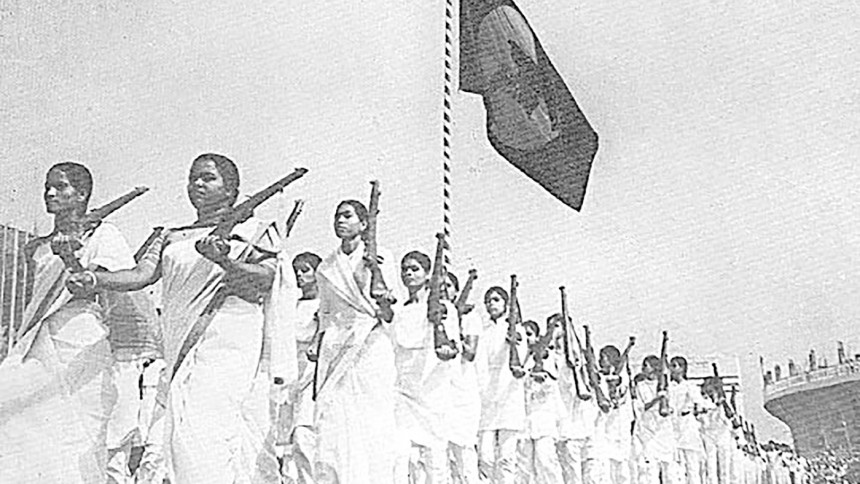Gender in Bangabandhu’s Regime

The first government of Bangladesh was formed as a government-in-exile on 17th of April 1971. Bangabandhu, who was detained in Pakistan at that time, was made the President of Bangladesh. On behalf of the President, some Awami League leaders were actually running the government during that period. The mission of the government was to facilitate the liberation war and secure international cooperation for Bangladesh. It was successful in its mission as within a few months, many people joined the Mukti Bahini (liberation force). Naturally, this government had no scope to particularly think about women. Still, many women joined the Mukti Bahini as freedom fighters, many others facilitated the war through various means. Hence, this government is marked with a vibrant and large scale of women’s movement which happened for the first time in the history of Bangladesh.
After being freed from Pakistani prison, Bangabandhu returned to an independent but devastated Bangladesh on 10th of January 1972. Therefore, a lot of challenges were awaiting him. The greatest challenge for him was to make a Constitution for Bangladesh. In order to tackle that, he issued a Provisional Constitutional Order stipulating a unitary parliamentary form of government. Accordingly, he resigned from the post of the President and became the Prime Minister. Hence, the second government under the leadership of Bangabandhu took over. As a result, Bangladesh got a Constitution on 4th of November 1972, which became effective on 16th of December in the same year.
The 1972 Constitution was very gender friendly indeed. It clearly stated that steps should be taken to ensure participation of women in all spheres of public life (Article 28). Considering the socio-economic and cultural constraints faced by women in our society, it reserved 15 seats for women in the Parliament for 10 years (Article 65.3). Nonetheless, there were no territorial constituencies for the reserved seats. Also, a system of indirect election was put in place for the reserved seats, i.e., the directly elected members of the Parliament were to elect the female members of the reserved seats which was 5% of the directly elected seats. This Constitutional provision was therefore criticised by different women’s group.
Another challenge for Bangabandhu was to reestablish the social cohesion which was torn apart during the liberation war of Bangladesh. Reportedly, at least 200,000 women were victims of rape and other kind of sexual and gender-based violence during the nine months of the liberation war. Later, these women were awarded with the title of war heroines (Birangonas). Although the androcentric social culture politically recognised their sacrifices, Bangladeshi society actually was not ready to accept them. It was observed that the liberation war divided the patriarchal society of Bangladesh into different fractions but could not tear the texture of patriarchy. Therefore, on one hand, integrating the war heroines (Birangonas) into the society was a great challenge for him; on the other hand, it was much needed for establishing social cohesion in newly emerged Bangladesh. This led him to destroy the initially prepared list of the Birangonas, as a part of his efforts to reestablishing the social cohesion.
Amidst these challenges, the first parliamentary election was held in Bangladesh in 1973. The ruling Awami League won 291 seats in the Parliament out of 300 seats. Hence, the third government under the leadership of Bangabandhu took over. It was observed that women were only marginally involved in the 1973 electoral contest. Although only 2 women contested out of 980 candidates in the 1973 parliamentary election, no one came out successful. However, as per the Constitutional provision, 15 women were nominated from Awami League to the reserved seats for women in the Parliament. Later in the same year, a local government election was held in Bangladesh and for the first time in the history of the land the statutory representation of women was ensured at the Union Parishad level. However, in 1973 local government election, only one woman from Rangpur was elected as the chairman of a Union Parishad out of 4352 Unions.
Despite the landslide victory in the 1973 parliamentary election, a deep political crisis arose with the famine in 1974. This led Bangabandhu to take a masculine decision of moving from one party domination in the parliament to a single party system. Therefore, the Constitution was amended for a one-party presidential form of government in January 1975. Hence, the fourth government under the leadership of Bangabandhu took over. Bangladesh Krishak Shramik Awami League (BAKSAL) was formed dissolving all other political parties. Gender issues were taken into consideration in BAKSAL as women constituted a significant front among five fronts of BAKSAL: peasants, workers, youth, student and women. The creation of BAKSAL, however, threatened the status quo of the existing power relations in the society and promoted further factionalism in the politics. As a result, before completion of his new political experiment, Bangabandhu along with his extended family members was assassinated by a group of junior military officers under the auspices of external allies on 15th of August 1975.
The writer is a researcher of Political Science, University of Dhaka.


 For all latest news, follow The Daily Star's Google News channel.
For all latest news, follow The Daily Star's Google News channel. 



Comments